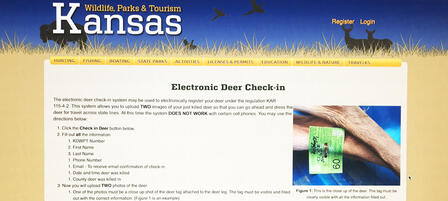Plan Ahead For Field Care Of Deer Meat

PRATT – Deer hunters have been anxiously awaiting the Kansas firearm deer season, Nov. 29-Dec. 10, 2017, making travel plans, organizing gear, scouting hunting areas and sighting in their rifles. While success is never guaranteed, you should also make plans for field care of your deer to ensure you and your family enjoy healthy and delicious venison long after the hunt.
Field dressing your deer as soon as possible is the first and most important step to cooling the meat. Next, date and sign the carcass tag that came with your permit and attach it to the hock of the rear leg. If you printed your permit and carcass tag from a desktop computer, you’ll want to enclose the tag in a sealable plastic bag to protect it and use a zip-tie to affix it to the leg. Regulation requires validating and attaching your carcass tag before moving the deer from the kill site, and deer taken with an antlerless-only permit must be transported with the head attached to the carcass to verify antlerless status.
However, when temperatures are warm or if you will be transporting your deer a considerable distance, you may opt to bone the meat out in the field and transport it on ice in coolers. To do this with a deer taken with an antlerless-only permit, you will need to register the deer electronically.
The Kansas Department of Wildlife, Parks and Tourism’s (KDWPT) electronic registration process is voluntary and only necessary to bone out an antlerless deer. Hunters can use their smartphones to access the electronic deer check-in system at www.ksoutdoors.com and click “Deer Check-in.”
The electronic registration process requires hunters to email two photographs — one close-up clearly showing the completed tag attached to the deer and a second showing the entire body of the deer with the head still attached. The process also requires the hunter’s KDWPT permit number, time and date of kill, and county where the deer was taken. Once registration is complete, a confirmation number will be issued by email. This confirmation number must be retained while transporting the meat.
If Internet access is unavailable at the kill site, hunters can retain the photographs while in transit and a registration number can be obtained later.
This system can be especially convenient for nonresident hunters who will take deer meat across state lines. Because chronic wasting disease (CWD) has been detected in Kansas deer, some states may have special regulations limiting the parts of the deer that may be brought in. Boning a deer out in the field is the best way to prevent spreading diseases such as CWD.
For more information on Kansas’ big game regulations, consult the 2017 Kansas Hunting and Furharvesting Regulations Summary, or visit ksoutdoors.com and click “Hunting,” then “Hunting Regulations.”
-30-









